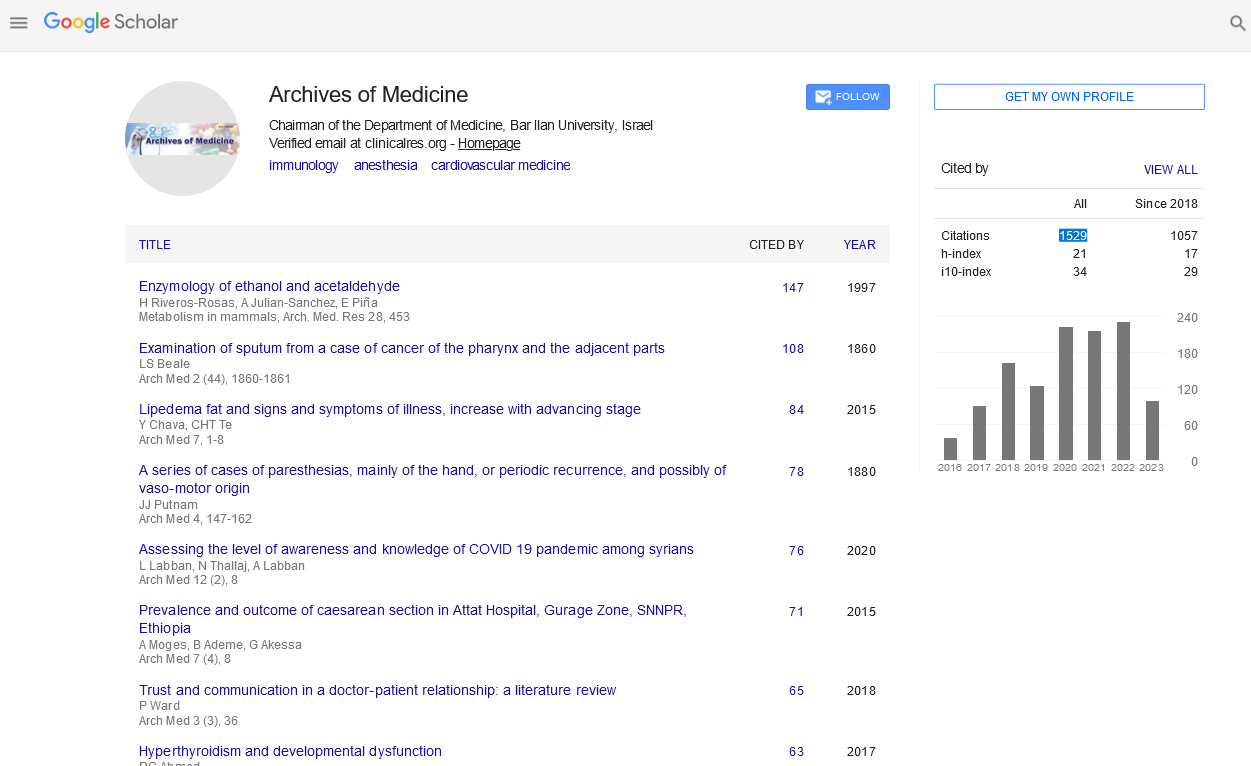Review - (2024) Volume 16, Issue 2
Intrinsic Kidney Pathology: Exploring the Inner Landscape of Renal Disorders
Jeffrey Troy*
Department of Medical Education, Kolling Institute of Medical Research, Royal North Shore Hospital, St. Leonards, Sydney, NSW 2065, Australia
*Correspondence:
Dr.
Jeffrey Troy, Department of Medical Education, Kolling Institute of Medical Research, Royal North Shore Hospital, St. Leonards, Sydney, NSW 2065,
Australia,
Email:
Received: 25-Feb-2024, Manuscript No. ipaom-24-14853;
Editor assigned: 27-Feb-2024, Pre QC No. P-14853;
Reviewed: 14-Mar-2024, QC No. Q-14853;
Revised: 21-Mar-2024, Manuscript No. R-14853;
Published:
28-Mar-2024
Abstract
The kidneys play a vital role in maintaining homeostasis within the
body, filtering waste products and regulating electrolyte balance.
Intrinsic kidney pathology encompasses a diverse array of disorders,
ranging from glomerular diseases to tubulointerstitial nephritis and
vascular disorders. Understanding the intricate inner landscape of renal
disorders involves unraveling the complex interactions between genetic
predisposition, environmental factors and immune dysregulation.
This abstract provides a brief overview of intrinsic kidney pathology,
highlighting key mechanisms underlying renal dysfunction and paving
the way for targeted therapeutic interventions.
Keywords
Renal dysfunction; Therapeutic interventions; Kidney
pathology; Tubulointerstitial nephritis; Vascular disorders; Regulating
electrolyte balance
Introduction
The kidneys, two bean-shaped organs nestled in
the lower back, play a pivotal role in maintaining the
body's internal balance. From filtering waste and excess
fluids to regulating electrolytes and blood pressure, their
functions are indispensable for overall health. However,
these vital organs are susceptible to a myriad of intrinsic
pathologies, ranging from acute injuries to chronic
diseases, each presenting unique challenges in diagnosis
and treatment. In this article, we delve into the intricate
landscape of intrinsic kidney pathology, unraveling the
complexities of renal disorders.
Literature Review
Anatomy and function
Before delving into pathology, it's essential to
understand the normal anatomy and function of the
kidneys. Each kidney consists of millions of nephrons,
the functional units responsible for filtering blood
and producing urine. The nephron comprises a
glomerulus—a cluster of tiny blood vessels—and a
tubule, where filtration, reabsorption and secretion occur.
Renal blood flow, controlled by intricate mechanisms,
ensures adequate filtration while maintaining systemic
homeostasis [1].
Acute Kidney Injury (AKI)
Acute kidney injury refers to a sudden decline in
kidney function, often triggered by conditions like
dehydration, severe infections, or nephrotoxic drugs.
AKI manifests as a rapid rise in serum creatinine and a
decrease in urine output, indicating impaired filtration
and/or tubular dysfunction. The severity can range from
mild injury to complete renal shutdown, necessitating
immediate medical intervention. Timely diagnosis,
often through serum biomarkers and imaging studies,
is crucial for mitigating further damage and improving
outcomes [2].
Glomerular disorders
Glomerular diseases affect the filtration function of the
kidneys, leading to proteinuria, hematuria and impaired
renal function. Conditions like glomerulonephritis,
membranous nephropathy and IgA nephropathy involve
immune-mediated damage to the glomeruli, resulting in inflammation and scarring. Diagnosis typically involves
urine analysis, renal biopsy and serological tests to identify
underlying causes and guide treatment strategies, which
may include immunosuppressive therapy or supportive
care [3].
Tubulointerstitial diseases
Tubulointerstitial disorders primarily affect the
tubules and interstitium of the kidneys, disrupting
electrolyte balance, acid-base regulation and tubular
function. Conditions such as acute tubular necrosis
(ATN), interstitial nephritis and polycystic kidney disease
(PKD) can impair renal function and lead to progressive
kidney damage. Diagnosis often relies on clinical history,
urine analysis, imaging studies and sometimes renal
biopsy to determine the underlying pathology and guide
management, which may include supportive measures
and targeted therapies [4].
Chronic Kidney Disease (CKD)
Chronic kidney disease encompasses a spectrum of
progressive renal disorders characterized by persistent
kidney damage and declining function over time.
Hypertension, diabetes mellitus and glomerular diseases
are common etiologies of CKD, ultimately leading to
end-stage renal disease (ESRD) if left untreated. Early
detection through routine screening, including blood
tests and urine analysis, is crucial for implementing
interventions to slow disease progression, such as lifestyle
modifications, medication management and renal
replacement therapy (e.g., dialysis or transplantation)
[5,6].
Discussion
Intrinsic kidney pathology encompasses a vast array
of conditions that affect the structure and function of the
kidneys from within. These disorders can originate from
various factors such as genetic predisposition, immunemediated
processes, infections, toxins and metabolic
disturbances. Understanding the inner landscape of
renal disorders is crucial for accurate diagnosis, effective
management and targeted therapeutic interventions.
One of the primary areas of interest within intrinsic
kidney pathology is glomerular diseases, which involve
the filtration units of the kidneys known as glomeruli.
Conditions such as IgA nephropathy, membranous
nephropathy and focal segmental glomerulosclerosis
(FSGS) represent just a few examples of glomerular
disorders with diverse underlying mechanisms and
clinical presentations. These diseases often manifest
as proteinuria, hematuria and varying degrees of renal
dysfunction, highlighting the importance of renal biopsy
and histopathological evaluation in their diagnosis.
Beyond glomerular diseases, intrinsic kidney
pathology encompasses tubulointerstitial disorders,
which involve the tubules and interstitium of the kidneys.
Acute tubular necrosis (ATN), interstitial nephritis and
polycystic kidney disease (PKD) are among the conditions
affecting these structures. ATN, often precipitated by
ischemic or nephrotoxic insults, can lead to acute kidney
injury (AKI) characterized by impaired renal function
and electrolyte imbalances. Interstitial nephritis, on the
other hand, may result from medications, infections,
or autoimmune processes, leading to inflammation and
fibrosis within the kidney parenchyma.
In addition to glomerular and tubulointerstitial
disorders, intrinsic kidney pathology encompasses
vascular diseases such as renal artery stenosis, thrombotic
microangiopathies and renal vasculitis. These conditions
can disrupt renal blood flow, impairing filtration and
leading to hypertension, ischemia and renal insufficiency.
The inner landscape of renal disorders is complex
and multifaceted, requiring a comprehensive approach
to diagnosis and management. Clinicians rely on a
combination of clinical assessment, laboratory testing,
imaging studies and histopathological evaluation to
elucidate the underlying etiology and guide treatment
strategies. Moreover, advancements in molecular
diagnostics and targeted therapies hold promise for
improving outcomes in patients with intrinsic kidney
pathology, underscoring the importance of ongoing
research and collaboration in the field.
Conclusion
Intrinsic kidney pathology encompasses a diverse
array of disorders that affect the structure and function
of the kidneys, posing significant challenges in diagnosis
and management. From acute injuries like AKI to chronic
conditions like CKD, each disorder requires a tailored
approach to treatment, emphasizing the importance
of timely intervention and multidisciplinary care.
Continued research into the underlying mechanisms of
renal disease and advancements in diagnostic modalities
hold promise for improving outcomes and alleviating
the burden of kidney disorders on global health. By
unraveling the inner landscape of renal pathology, we
move closer to preserving kidney health and enhancing
the quality of life for individuals affected by these
conditions.
Acknowledgement
None.
Conflict of Interest
None.
References
- Drescher J. Out of DSM: Depathologizing homosexuality. Behav Sci. 2015;5(4):565-575.
Google Scholar, Crossref, Indexed at
- Mulvey P, Duong V, Boyer S, et al. The ecology and evolution of Japanese encephalitis virus. Pathogens. 2021;10(12):1534.
Google Scholar, Crossref, Indexed at
- MacRae N. Turf, team and town: A geriatric interprofessional education program. Work. 2012;41(3):285-292.
Google Scholar, Crossref, Indexed at
- Keijsers CJ, Brouwers JR, de Wildt DJ, et al. A comparison of medical and pharmacy students' knowledge and skills of pharmacology and pharmacotherapy. Br J Clin Pharmacol. 2014;78(4):781-788.
Google Scholar, Crossref, Indexed at
- Kattamis A, Forni GL, Aydinok Y, et al. Changing patterns in the epidemiology of β‐thalassemia. Eur Oncol Haematol. 2020;105(6):692-703.
Google Scholar, Crossref, Indexed at
- Casu C, Oikonomidou PR, Chen H, et al. Minihepcidin peptides as disease modifiers in mice affected by β-thalassemia and polycythemia vera. Am J Hematol. 2016; 128(2):265-276.
Google Scholar, Crossref, Indexed at






